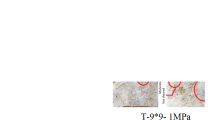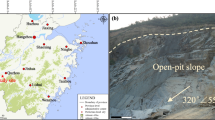Abstract
Numerical modeling of complex rock engineering problems involves the use of various input parameters which control usefulness of the output results. Hence, it is of utmost importance to select the right range of input physical and mechanical parameters based on laboratory or field estimation, and engineering judgment. Joint normal and shear stiffnesses are two popular input parameters to describe discontinuities in rock, which do not have specific guidelines for their estimation in literature. This study attempts to provide simple methods to estimate joint normal and shear stiffnesses in the laboratory using the uniaxial compression and small-scale direct shear tests. Samples have been prepared using rocks procured from different depths, geographical locations and formations. The study uses a mixture of relatively smooth natural joints and saw-cut joints in the various rock samples tested. The results indicate acceptable levels of uncertainty in the calculation of the stiffness parameters and provide a database of good first estimates and empirical relations which can be used for calculating values for joint stiffnesses when laboratory estimation is not possible. Joint basic friction angles have also been estimated as by-products in the small scale direct shear tests.









Similar content being viewed by others
References
Bandis SC, Lumsden AC, Barton NR (1983) Fundamentals of rock joint deformation. Int J Rock Mech Min Sci 20(6):249–268
Barton N, Lien R, Lunde J (1974) Engineering classification of rock masses for the design of tunnel support. Rock Mech 6:189–236
Bieniawski ZT (1974) Geomechanics classification of rock masses and its application in tunneling. In: Proc. 3rd Int. Cong. Rock Mech Vol. 2, pp 27–32
Byerlee J (1978) Friction of rocks. Pure Appl Geophys 116(4–5):615–626
Deere DU, Hendron AJ, Patton FD, Cording EJ (1967) Design of surface and near-surface construction in rock. In: The 8th US Symposium on Rock Mechanics (USRMS). American Rock Mechanics Association
Dieterich JH (1992) Earthquake nucleation on faults with rate-and state-dependent strength. Tectonophysics 211(1):115–134
Goodman RE (1976) Methods of geological engineering in discontinuous rocks. West, New York
Goodman RE (1974) The mechanical properties of joints. In: Proceedings of the Third Congress on ISRM, Denver, vol. 1A, Washington, DC: National Academy of Sciences. pp 127–140
Goodman RE, Taylor RL, Brekke TL (1968) A model for the mechanics of jointed rock. J Soil Mech Found Div Proc Am Soc Civ Eng 94(SM3):637–659
Helmstetter A, Sornette D, Grasso JR, Andersen JV, Gluzman S, Pisarenko V (2004) Slider block friction model for landslides: application to Vaiont and La Clapière landslides. J Geophys Res: Solid Earth 109(B2):1978–2012
Hoek E, Marinos P (2007) A brief history of the development of the Hoek-Brown failure criterion. Soils Rocks 2:1–8
Hoek E, Kaiser PK, Bawden WF (1995) Support of underground excavations in hard rock. A. A. Balkema, Rotterdam
Hoek E, Carranza-Torres C, Corkum B (2002) Hoek-Brown failure criterion-2002 edition. Proc NARMS-Tac 1:267–273
Jiang XW, Wan L, Wang XS, Liang SH, Hu BX (2009) Estimation of fracture normal stiffness using a transmissivity-depth correlation. Int J Rock Mech Min Sci 46(1):51–58
Jing L, Nordlund E, Stephansson O (1994) A 3-D constitutive model for rock joints with anisotropic friction and stress dependency in shear stiffness. Int J Rock Mech Min Sci 31(2):173–178
Malama B, Kulatilake PHSW (2003) Models for normal fracture deformation under compressive loading. Int J Rock Mech Min Sci 40:893–901
Marone C (1998) Laboratory-derived friction laws and their application to seismic faulting. Annu Rev Earth Planet Sci 26(1):643–696
Matsuki K, Wang EQ, Sakaguchi K, Okumura K (2001) Time dependent closure of a fracture with rough surfaces under constant normal stress. Int J Rock Mech Min Sci 38(5):607–619
Romana M (1985) New adjustment ratings for application of Bieniawski classification to slopes. In: Proceedings of the International Symposium on the Role of Rock Mechanics in Excavations for Mining and Civil Works. International Society of Rock Mechanics, Zacatecas, pp 49–53
Ruina A (1983) Slip instability and state variable friction laws. J Geophys Res 88(10):359–10
Rutqvist J (1995) Determination of hydraulic normal stiffness of fractures in hard rock from well testing. Int J Rock Mech Min Sci 32(5):513–523
Shehata WM (1971) PhD thesis, quoted in Sharp JC and Maini YNT, in fundamental considerations on the hydraulic characteristics of joints in rock. Proceedings of the Symposium on Percolation Through Fissured Rock, paper no. T1-F, Stuttgart, 1972
Standard ASTM D5607–08 (2008) Standard test method for performing laboratory direct shear strength tests of rock specimens under constant normal force. Annual Book of ASTM Standards. American Society for Testing and Materials, West Conshohocken
Standard ASTM D7012 (2014) Standard test method for compressive strength and elastic moduli of intact rock core specimens under varying states of stress and temperatures. ASTM International, West Conshohocken
Stille H, Groth T, Fredriksson A (1982) FEM-analysis of rock mechanical problems with JOBFEM, vol 307(1). Stiftelsen Bergteknisk Forskning–BeFo, Stockholm, p 82
Sun Z, Gerrard C, Stephansson O (1985) Rock joint compliance tests for compression and shear loads. Int J Rock Mech Min Sci 22(4):197–213
Swan G (1983) Determination of stiffness and other joint properties from roughness measurements. Rock Mech Rock Eng 16:19–38
Veveakis E, Vardoulakis I, di Toro G (2007) Thermoporomechanics of creeping landslides: the 1963 Vaiont slide, northern Italy. J Geophys Res: Earth Surf 112(F3):2003–2012
Wang JA, Park HD (2001) Comprehensive prediction of rockburst based on analysis of strain energy in rocks. Tunn Undergr Space Tech 16(1):49–57
Wang X, Kulatilake PHSW, Song WD (2012) Stability investigations around a mine tunnel through three-dimensional discontinuum and continuum stress analyses. Tunn Undergr Space Tech 32:98–112
Acknowledgments
The support provided by the various mining companies through providing geological data, rock core and/or block samples, and allowing access to the mine to perform field investigations is very much appreciated. The work was funded by the NIOSH of the Centers for Disease Control and Prevention (Contract No. 200-2011-39886). We also thank two anonymous reviewers for their critique which helped improve the paper.
Author information
Authors and Affiliations
Corresponding author
Rights and permissions
About this article
Cite this article
Kulatilake, P.H.S.W., Shreedharan, S., Sherizadeh, T. et al. Laboratory Estimation of Rock Joint Stiffness and Frictional Parameters. Geotech Geol Eng 34, 1723–1735 (2016). https://doi.org/10.1007/s10706-016-9984-y
Received:
Accepted:
Published:
Issue Date:
DOI: https://doi.org/10.1007/s10706-016-9984-y




